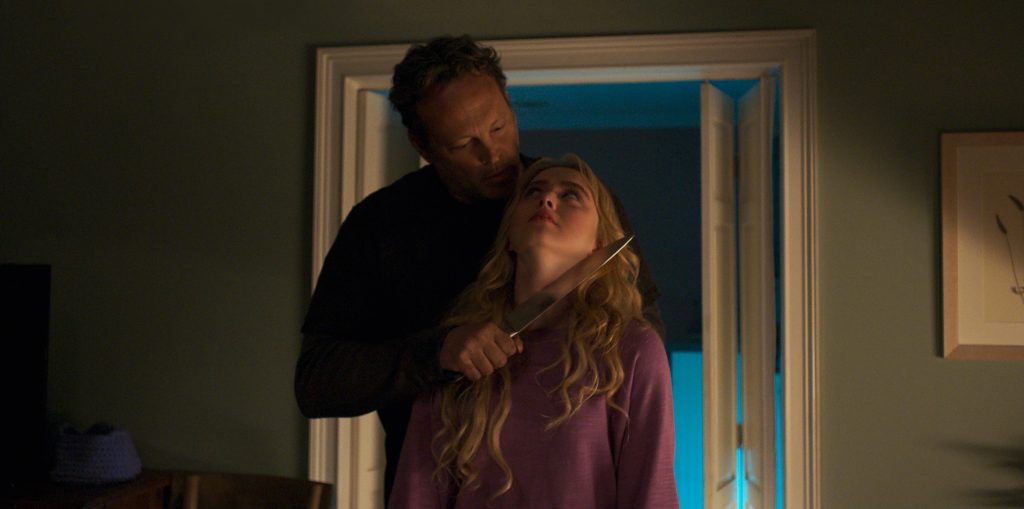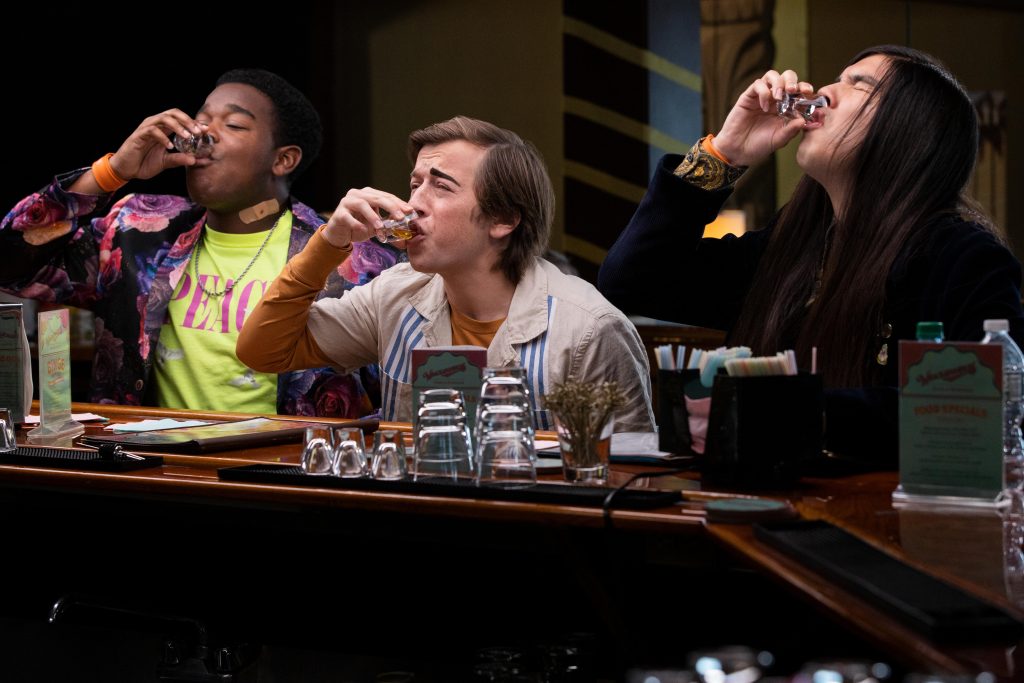September 8, 2021
by Carla Hay

Directed by Aron Gaudet and Gita Pullapilly
Culture Representation: Taking place in the Southwest region of the United States and in Chihuahua, Mexico, the comedy film “Queenpins” features a predominantly white cast of characters (with some black people and Latinos) representing the working-class and middle-class
Culture Clash: A neglected housewife and her best friend team up for a coupon-stealing scam that could make them millions of dollars.
Culture Audience: “Queenpins” will appeal primarily to people who are fans of star Kristen Bell and anyone who likes cliché-filled comedies.

“Queenpins” could have been a hilarious satire of coupon culture, but this boring and unimaginative comedy fizzles at the halfway mark and never recovers. Kristen Bell is usually the best thing about any of the bad movies she’s in, but in “Queenpins,” she just seems to be going through the motions. This movie has several talented stars but they’re stuck portraying two-dimensional characters and are forced to say a lot of cringeworthy dialogue that isn’t very funny.
Written and directed by husband-and-wife duo Aron Gaudet and Gita Pullapilly, “Queenpins” hits all the cliché beats of comedies about ordinary people who decide to rob the rich in order to fight back at an unfair system. The movie is inspired by true events. In “Queenpins,” the thieves are unhappily married homemaker Connie Kaminski (played by Bell) and unemployed YouTube personality Joanna “JoJo” Johnson (played by Kirby Howell-Baptiste), who are best friends and next-door neighbors in Phoenix. Connie and JoJo are in debt and are tired of being broke.
Within six months, Connie and JoJo end up making $5 million in a scam of stealing coupons from a coupon redemption company called Advanced Solutions and then reselling the coupons. Because they’re committing fraud against major corporations, Connie and JoJo think of themselves as modern-day Robin Hoods—except they don’t really give any of their misbegotten fortune to poor people. They end up keeping the $5 million for themselves. And then, they panic because they think they should launder the money. And so, Connie and JoJo get mixed up in illegal gun deals and other shenanigans.
This scam was all Connie’s idea. She’s become a coupon addict, ever since she had a miscarriage of a baby girl. Connie is using her coupon addiction to cope with her grief. Connie’s aloof husband Rick Kaminski (played by Joel McHale) is a senior audit specialist for the Internal Revenue Service. The couple had been trying to start a family through in vitro fertilization treatments, which have left Connie and Rick more than $71,000 in debt.
Connie and Rick’s arguments with each other are mostly about money. Because of Connie’s coupon-using obsession, she has overstocked their home with products that they don’t need. After the miscarriage, Rick decided to take on more traveling responsibilities in his job, so he’s away from home for about three weeks out of any given month.
JoJo lives with her cranky mother Josephine Johnson (played by Greta Oglesby), also known as Mama Josie, who’s gotten tired of supporting her jobless daughter. JoJo has been trying and failing to become a beauty-product guru on YouTube. And she’s heavily in debt because she was the victim of identity theft, which ruined her credit. At first, JoJo is very reluctant to get involved in Connie’s plans to commit coupon fraud, but Connie convinces JoJo that they probably won’t get caught.
During their coupon-theft scheme, Connie and JoJo predictably come across a series of “wacky characters” and the inevitable people who try to bust these coupon scammers. The first authority figure who gets suspicious of this fraud is uptight but dimwitted Ken Miller (played by Paul Walter Hauser), a loss protection manager for the Southwest region of a supermarket chain called A&G. He’s eventually joined by gruff-mannered Simon Kilmurry (played by Vince Vaughn), a U.S. Postal Service inspector. Ken and Simon both have huge egos and inevitably clash over who should be in charge of the investigation.
“Queenpins” has a talented cast, but the problem is in the dull screenplay and hackneyed direction. Connie and JoJo have believable chemistry together as friends, but the supporting characters just come in and out of the story like disconnected pieces of a puzzle. Bebe Rexha plays a bustier-wearing, cynical ex-friend of Connie’s named Tempe Tina, who is a con artist/computer hacker extraordinaire who dresses in all-black clothing. Connie and JoJo go to Tina for advice on how to be successful criminals.
“Queenpins” attempts to make jokes about race relations that end up falling flat. JoJo’s mother constantly has to point out what she sees as differences between white people and black people. Mama Josie has a fear of JoJo losing her “blackness” by hanging out too much with white people like Connie and having the same interests that Connie has. Mama Josie’s mindset is racist, but it’s somehow supposed to be excused and thought of as humorous in this movie. This attitude becomes annoying after a while.
And when Connie and JoJo go to Chihuahua, Mexico, they recruit a married Mexican couple named Alejandro (played by Francisco J. Rodriguez) and Rosa (played by Ilia Isorelýs Paulinoa), who work at Advanced Solutions’ biggest factory. Alejandro and Rosa are enlisted to steal the boxes of coupons that end up making about $5 million for Connie and JoJo. When Connie and JoJo first meet Alejandro and Rosa, they follow the couple by car when they see Alejandro and Rosa outside of the factory.
Alejandro and Rosa mistakenly think that Connie and JoJo want to rob them, so the couple almost physically assaults the two pals, until Connie and JoJo explain that they want to hire Alejandro and Rosa for this theft. Rosa explains why she and her husband were so quick to attack: “You never follow people in Mexico,” thereby stereotyping Mexico as a dangerous place all the time.
The movie makes a very weak attempt at social commentary about labor exploitation and how American companies outsource jobs to other countries for cheaper labor. But those ideas are left by the wayside, as the movie follows a very over-used formula of amateur criminals (Connie and JoJo) who make things worse for themselves. As an example of how “Queenpins” brings up and then abandons labor exploitation issues, Connie and JoJo are shocked that Alejandro and Rosa each make a factory salary of only $2 an hour, but then Connie and JoJo continue with their selfish and greedy plans.
Viewers won’t have much sympathy for Connie and JoJo because they make so many dumb mistakes. As a way to sell their stolen coupons, Connie and JoJo create a website, which is not on the Dark Web, called Savvy Super Saver. JoJo also peddles the coupons on her YouTube channel, thereby making it very easy to identify her as one of the culprits.
“Queenpins” is told mainly from Connie’s perspective, because she is the one who does the movie’s voiceover narration. Connie has an unusual history as a three-time Olympic gold medalist in race walking, but that background is barely explored in the movie. Instead, Connie says a lot of uninteresting things in her bland dialogue.
Of her Olympic experiences, she comments: “You know what that’s worth in the real world? Nothing!” She has this personal motto on saving money in her coupon fixation: “Watch the pennies, and the dollars will take care of themselves.” And when Connie decides to become a criminal, she explains her justification to JoJo this way: “You know who gets rewarded? People who don’t follow the rules. It’s time we start bending them a little!”
Among the other irritating aspects of “Queenpins” are the overly intrusive sitcom-ish musical score and soundtrack choices. When Connie struts into a business meeting with the fake persona of being a powerhouse entrepreneur, she wears a snug-fitting blue dress and blue blazer, while the movie’s soundtrack blares Mitch Ryder and the Detroit Wheels’ 1967 hit “Devil With a Blue Dress On.” It’s just too “on the nose” and corny, just like the majority of this movie. There’s a gross (but not too explicit) defecation scene involving Ken, after he talks about his food habits and defecation routine, which seems like a lazy and cheap shot at someone who’s plus-sized.
Some of the other supporting characters in “Queenpins” include postal carrier Earl (played by Dayo Okeniyi), who has a crush on JoJo and becomes her obvious love interest; Greg Garcia (played by Eduardo Franco), a jaded cashier at the A&G store where Connie does her grocery shopping; a coupon buyer named Crystal (played by Annie Mumolo), who reports her suspicions about JoJo; and Agent Park (played by Jack McBrayer), one of the law enforcement agents involved in a sting to capture Connie and JoJo.
“Queenpins” has all the characteristics of a substandard TV comedy, which means it’s certainly not worth the price of a movie ticket. People who are very bored, have low standards, or are die-hard fans of any of the “Queenpins” headliners might get some enjoyment out of this film. At one point in the movie, Bell’s Connie character says, “You may be asking yourself, ‘Who won and who lost in all of this?’ I guess that’s really for you to decide.” If you don’t want to lose or waste any time on silly comedies that don’t do anything original, then you can decide to skip “Queenpins.”
STX will release “Queenpins” in select U.S. cinemas (exclusively in Cinemark theaters) on September 10, 2021. Paramount+ will premiere “Queenpins” on September 30, 2021.






